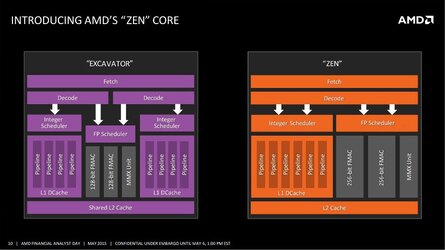Pretty sure the 1st gen Athlon was marginally ahead. Then Intel released the P4, and funnily enough a couple of revampled P3's (Tualatin core) which scaled up to 1.4GHz and handily outperformed the 2.4GHz P4's. Problem is that most of the early P4's were saddled with slow RAM when that architecture was optimized for high bandwitdth RAM. I'm not arguing the P4 was any good, I'm not, it was a pig. Just that Intel sadled it slow single data rate RAM in many systems due to the prohibitive cost of Rambus memory. Wasn't until 266MHz DDR that things looked a bit better.
Anyway, my poor old FX will continue in use until it won't run current games at a decent rate. Generally I just update the video card. Can't be bothered updating anymore.
Athlons had higher clock but clock to clock were slower than P3 because P3 had much larger and faster cache. AMD as 1st reached magical clock of 1GHz on Slot A CPU.
When P3 passed 1.13GHz then Intel was focused on P4 with overpriced Rambus memory which wasn't really as fast as expected. Higher clocked P3 were overpriced that days and hardly available. Intel was manufacturing them in limited quantities and tried to push P4 some more. All knew that P3 is faster but since barely anyone could buy them then all moved to P4.
Funny were first comparisons of FX to P4. It was scalling like 8 threaded P4 ... high clock but poor performance. Pentium D wasn't any better but Conroe changed a lot. First CPU for a long time which was giving real performance boost and it was worth to move to the new platform. It was also in reasonable price comparing to earlier generations.
Many people say that AMD made mistake buying ATI but if they wouldn't make it then there would be no AMD right now. For a years only ATI part of the company is bringing profits and actually counts on the market.
Right now AMD is trying to find its place. They move to SoC as Intel is not so strong there. Also they try to push IGP as they have probably the best option on the market. The main issue is that higher APUs are still really slow comparing to their wattage. Mobile users can live with slower graphics but they want faster CPU. AMD is offering them fast graphics which they don't need and slow CPU which uses more power than the competition. They just can't win this way.
Right now they delay every new series while Intel is releasing new products with small steps but most potential customers have no idea about hardware so Intel can advertise any new technology as a breakthrough and product will sell itself. AMD has one big problem here, many customers don't trust them. Instead of gaining this trust with more often released good products they release something like FX every 3-4 years and later try to sell it while barely anyone wants it.
Yea, my formula-z is tits. Much better than even their Sabortooth board which does really well for most people. Never had an issue on raid with AMD other than picking the proper driver for it where Intel is pretty much plug and play with MS os. That may change with W10, but I doubt that lol.
Many AM3+ boards had issues with RAID on early BIOS releases but ASUS didn't care to fix it for almost a year even for CHV. CHV had no RAID ROM. It had only option to set RAID but you couldn't adjust anything. So RAID without any cache options etc. At the end performance was 30-50% lower than expected. First fix was made by one of the users who added MSI 990FX RAID ROM to ASUS BIOS. ASUS made it work about half year later even though many users were complaining.
At the same time Gigabyte failed RAID options on their 990FX UD series. I was writing guides how to solve it as even Gigabyte staff wasn't sure and support was always answering that all is fine with their boards. Simply to enable any caching and correct RAID0/10 you had to enable RAID 5 and change some more options. Later you could enable caching in system. Without changes RAID performance was about 50% of what it should be and regardless of used SSD amount controller couldn't pass ~600MB/s. I made it beat Intel controllers running 3 SSD up to 1250MB/s while Intels couldn't pass 1.05-1.1GB/s because of hardware limitations.
